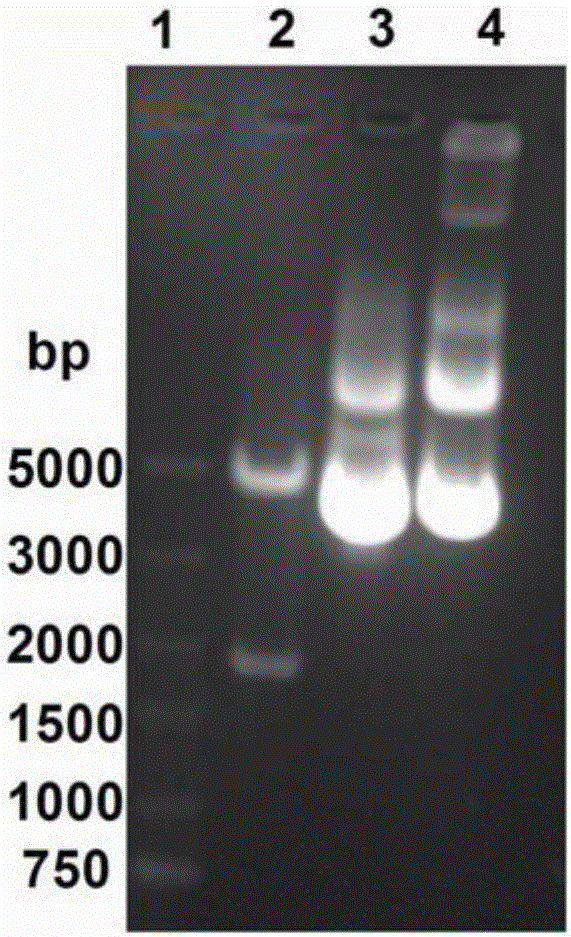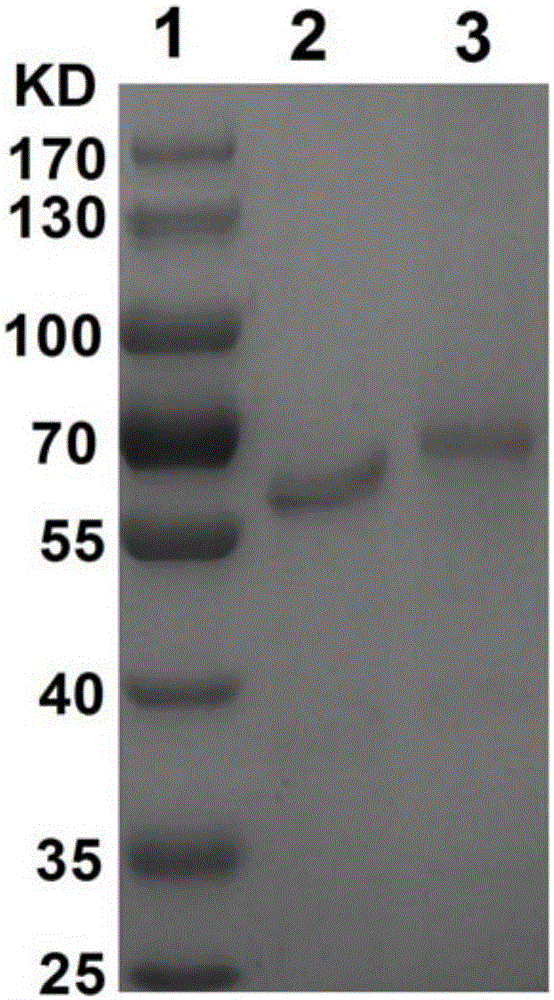Method for acquiring human alpha fetoproteins
A technology of alpha-fetoprotein and human, applied in animal/human protein, pregnancy protein, mammalian protein, etc., to achieve high purity and good activity
- Summary
- Abstract
- Description
- Claims
- Application Information
AI Technical Summary
Problems solved by technology
Method used
Image
Examples
Embodiment 1
[0028] Embodiment 1 utilizes the method for human alpha-fetoprotein expressed by Sf9 insect cell eukaryotic and pFastBac1 vectors
[0029] 1. The human alpha-fetoprotein gene (AFP) and the pFastBac1 vector were ligated after double digestion with restriction enzymes, and the E.coliDH5α bacteria containing the vector pFastBac1-AFP were transferred to 100mL ampicillin-containing bacteria at a ratio of 1:100. culture medium with shaking at 37°C overnight, and the expression plasmid was extracted.
[0030] 2. Identify the correct recombinant plasmid pFastBac1-AFP and transform it into E.coliDH10Bac, transform the connected plasmid into DH10Bac cells, and spread it on the LB containing kanamycin, gentamicin, tetracycline, IPGT and X-gal combination On the medium plate (the five components are mixed in a ratio of 1:1.5:2:1:4, and the mixed solution is added to the LB medium in a volume ratio of 1:1000), the blue and white spots are screened, and the insects are obtained by using the...
Embodiment 2
[0037] Embodiment 2 The method of human alpha-fetoprotein expressed by Sf9 insect cell eukaryotic and pFastBacDual vector
[0038] 1. The human alpha-fetoprotein gene and the pFastBacDual vector were digested with restriction endonucleases and ligated, and the ligated vector was transformed into E.coliDH10Bac to obtain a Bacmid expressing human alpha-fetoprotein. The Bacmid was transfected into Sf9 insect cells .
[0039] 2. Before transfection, put the cells in the logarithmic growth phase at an approximate density of 2×10 6 Each / mL Sf9 insect cells were evenly placed on the plate, and 2 mL of insect cell culture medium was added to each well, and stood at 27°C for 1 hour to allow the cells to adhere to the wall. It was observed under a microscope that 80% of the cells covered the plate.
[0040] Prepare the following solutions at the same time, solution A: add 5 μL of recombinant AFP / Bac to 100 μL of SFX-Insect insect cell culture medium, and mix well. Solution B: For each...
Embodiment 3
[0044] Example 3 The method of human alpha-fetoprotein expressed by Sf21 insect cell eukaryotic and pFastBac1 vector
[0045] 1. Ligate the human alpha-fetoprotein gene and the pFastBac1 vector after double digestion with restriction enzymes, transform the ligated vector into E.coliDH10Bac, and obtain the Bacmid expressing human alpha-fetoprotein. Transfect the Bacmid into Sf21 insect cells .
[0046] 2. Before transfection, put the cells in the logarithmic growth phase at an approximate density of 1 to 3×10 6 Each / mL Sf21 insect cells were evenly placed on the plate, and 2 mL of insect cell culture medium was added to each well, and stood at 27°C for 1 hour to allow the cells to adhere to the wall. It was observed under a microscope that 80% of the cells covered the plate.
[0047] Prepare the following solutions at the same time, solution A: add 5-20 μL of recombinant AFP / Bac to 100 μL of SFX-Insect insect cell culture medium, and mix well. Solution B: For each transfectio...
PUM
 Login to View More
Login to View More Abstract
Description
Claims
Application Information
 Login to View More
Login to View More - R&D
- Intellectual Property
- Life Sciences
- Materials
- Tech Scout
- Unparalleled Data Quality
- Higher Quality Content
- 60% Fewer Hallucinations
Browse by: Latest US Patents, China's latest patents, Technical Efficacy Thesaurus, Application Domain, Technology Topic, Popular Technical Reports.
© 2025 PatSnap. All rights reserved.Legal|Privacy policy|Modern Slavery Act Transparency Statement|Sitemap|About US| Contact US: help@patsnap.com



